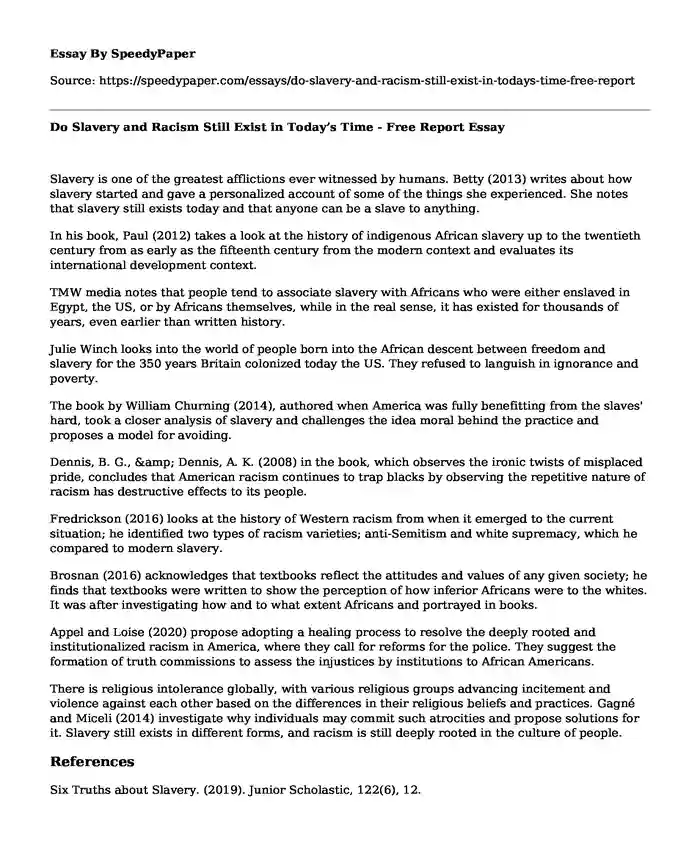Slavery is one of the greatest afflictions ever witnessed by humans. Betty (2013) writes about how slavery started and gave a personalized account of some of the things she experienced. She notes that slavery still exists today and that anyone can be a slave to anything.
In his book, Paul (2012) takes a look at the history of indigenous African slavery up to the twentieth century from as early as the fifteenth century from the modern context and evaluates its international development context.
TMW media notes that people tend to associate slavery with Africans who were either enslaved in Egypt, the US, or by Africans themselves, while in the real sense, it has existed for thousands of years, even earlier than written history.
Julie Winch looks into the world of people born into the African descent between freedom and slavery for the 350 years Britain colonized today the US. They refused to languish in ignorance and poverty.
The book by William Churning (2014), authored when America was fully benefitting from the slaves' hard, took a closer analysis of slavery and challenges the idea moral behind the practice and proposes a model for avoiding.
Dennis, B. G., & Dennis, A. K. (2008) in the book, which observes the ironic twists of misplaced pride, concludes that American racism continues to trap blacks by observing the repetitive nature of racism has destructive effects to its people.
Fredrickson (2016) looks at the history of Western racism from when it emerged to the current situation; he identified two types of racism varieties; anti-Semitism and white supremacy, which he compared to modern slavery.
Brosnan (2016) acknowledges that textbooks reflect the attitudes and values of any given society; he finds that textbooks were written to show the perception of how inferior Africans were to the whites. It was after investigating how and to what extent Africans and portrayed in books.
Appel and Loise (2020) propose adopting a healing process to resolve the deeply rooted and institutionalized racism in America, where they call for reforms for the police. They suggest the formation of truth commissions to assess the injustices by institutions to African Americans.
There is religious intolerance globally, with various religious groups advancing incitement and violence against each other based on the differences in their religious beliefs and practices. Gagné and Miceli (2014) investigate why individuals may commit such atrocities and propose solutions for it. Slavery still exists in different forms, and racism is still deeply rooted in the culture of people.
References
Six Truths about Slavery. (2019). Junior Scholastic, 122(6), 12.
Evans, B. (2013). Slavery : Where Did It Come From? First Edition Design Publishing.
Lovejoy, P. E. (2012). Transformations in Slavery : A History of Slavery in Africa: Vol. 3rd ed.Cambridge University Press.
The Truth about Slavery in History. (1997). TMW Media Group; http://ccc.idm.oclc.org/login?url=.
Julie Winch. (2014). Between Slavery and Freedom : Free People of Color in America From Settlement to the Civil War. Rowman & Littlefield Publishers.
Channing, W. E. (2014). Slavery. The Floating Press.
Dennis, B. G., & Dennis, A. K. (2008). Slaves to Racism : An Unbroken Chain From America to Liberia. Algora Publishing.
Fredrickson, G. M. (2002). Racism : A Short History. Princeton University Press.
Joo, H.-J. S. (2011). Old and new slavery, old and new racisms: strategies of science fiction in Octavia Butler’s Parables series. Extrapolation, 52(3), 279.
Brosnan, A. (2016). Representations of Race and Racism in the Textbooks Used in Southern Black Schools during the American Civil War and Reconstruction Era, 1861-1876. PaedagogicaHistorica: International Journal of the History of Education, 52(6), 718–733.
Appel, B., & Loyle, C. E. (2020). To fight US racism, research prescribes a nationwide healing process. Gale, Cengage Learning.
Author unknown. (2014). Pentecostalism in Africa: Presence and Impact of Pneumatic Christianity in Postcolonial Societies. Brill.
Gagne, A., Loumakis, S., & Miceli, C. A. (2016). The Global Impact of Religious Violence. Wipf and Stock.
Cite this page
Do Slavery and Racism Still Exist in Today's Time - Free Report. (2023, Dec 20). Retrieved from https://speedypaper.com/essays/do-slavery-and-racism-still-exist-in-todays-time-free-report
Request Removal
If you are the original author of this essay and no longer wish to have it published on the SpeedyPaper website, please click below to request its removal:
- Free Essay Sample on Technology and Bullying
- Immigration Research Paper Sample
- Free Essay: To What Extent Was The Emancipation Proclamation Effective In Abolishing Slavery?
- White by Law - Book Review Essay Example
- Free Essay on Equal Pay in Organizations
- Free Essay Example - Sexual Double Standards
- Essay Example on How Slavery Caused the Civil War
Popular categories





